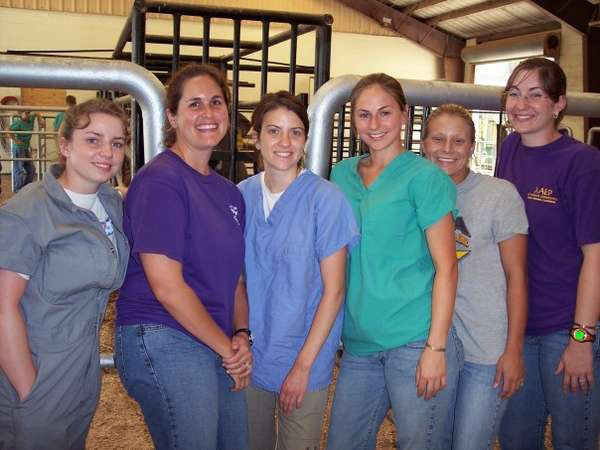Katrina at 20
20 heroic tales of people helping animals
as told to Sandra Sarr, LSU Vet Med strategic communications
Jenny Sones, (Class of 2008), CSU Equine Reproduction Laboratory reproduction specialist

LSU Vet Med Class of 2008: Drs. Jamie Charlie, Tricia Richardel, Jenny Sones, Laura Ward Ansel, and Emilie Seal Rouse, and Jessica Carey.
– Photo Credit: Dr. Jenny Sones
“In August 2005, I was starting my second year of veterinary school at LSU. We all knew something was brewing in the Gulf. Growing up in Baton Rouge, I knew the drill: Stock up on candles, batteries, bottled water, etc. Oh, and we would probably get a few days off school. YAY!!! One more day to cram for that virology test. I had no idea that life was about to change so drastically.
School was cancelled, and electricity was out most places except at the vet school. My colleagues set up temporary housing in our study rooms and other places throughout the vet school. We then began to learn of the effects of Katrina on our veterinary species—dogs, cats, horses, and more. These precious creatures were the reason why we studied, crammed, and signed up to endure the rigors of veterinary school. It was time to close the books and help! Although we were not licensed veterinarians yet, we were keen to provide aid in any way we could. I, along with lots of my classmates, volunteered at Parker Coliseum on the LSU campus, where displaced small animals were seeking refuge, and at Lamar Dixon, which became the shelter for large animals and small animals. These locations were overflowing not with 4H and hunter jumper shows, the events we were used to seeing there, but rather lost, displaced, and scared animals. We spend many hours doing anything we could, cleaning litter boxes, refilling water bowls, changing bedding, administering medications, and assisting the heroic volunteer veterinarians working tirelessly to treat the injured, sick, and rescued.
Lots of important lessons were learned during Katrina. Many animals were not reunited with their owners. That's when I learned the value of microchipping to permanently identify animals, gained an appreciation for animal search and rescue, and the value of quick response. You never know when the next disaster will occur! Since then, we have had more natural disasters that have afflicted our beloved veterinary species. The veterinary training at LSU during Katrina has benefited me and all of us as veterinarians.”